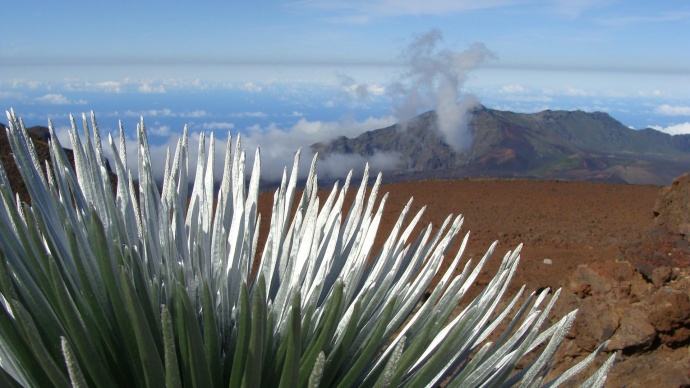Global Warming Poses Threat to Haleakalā Silverswords
By Wendy Osher
Researchers from the US Geological Survey say the iconic silversword plant atop Haleakalā on Maui has entered a period of substantial climate-related decline.
The USGS notes that new research published this week warns that global warming may have severe consequences for the already threatened silversword in its native habitat.
The report entitled “Climate-Associated Population Declines Reverse Recovery and Threaten Future of an Iconic High-Elevation Plant,” was published in the scientific journal Global Change Biology. It was co-authored by Paul Krushelnycky, a biologist with the University of Hawaiʻi at Mānoa, College of Tropical Agriculture and Human Resources; Lloyd Loope, scientist emeritus with the US Geological Survey; and others at the University of Hawai‘i at Mānoa, and University of Arizona.
Although climate change is predicted to place the plant at severe risk of extinction, researchers say the ecological processes involved in such extinctions are still poorly understood.
Authorities from the USGS say the Haleakalā silversword, Argyroxyphium sandwicense macrocephalum, grows only on a single volcano summit in Hawaiʻi, and is viewed by 1–2 million visitors annually.
The silversword grows for 20-90 years before the single reproductive event at the end of its life, at which time it produces as many as 600 flower heads.
The plant made a strong recovery from the early 20th-century threats through successful management practices. Threats included grazing by hoofed animals and gathering of plants by visitors.
A strong association of annual population growth rates with patterns of precipitation suggests the plants are undergoing increasingly frequent and lethal water stress, according to information released by the USGS.
“The silversword example foreshadows trouble for diversity in other biological hotspots,” said Dr. Krushelnycky in a media release, “and it also illustrates how even well-protected and relatively abundant species may succumb to climate-induced stresses.”
USGS Director Marcia McNutt said, “Despite the successful efforts of the National Park Service to protect this very special plant from local disturbance from humans and introduced species, we now fear that these actions alone may be insufficient to secure this plant’s future. No part of our planet is immune from the impacts of climate change,” she said.
The report is the first publication to result from a collaborative effort between research scientists and land managers at Haleakalā National Park. Their efforts are aimed at seeking to understand trends for the federally threatened plant.
The work was facilitated and funded by the National Park Service, along with US Geological Survey and US Fish and Wildlife Service.










